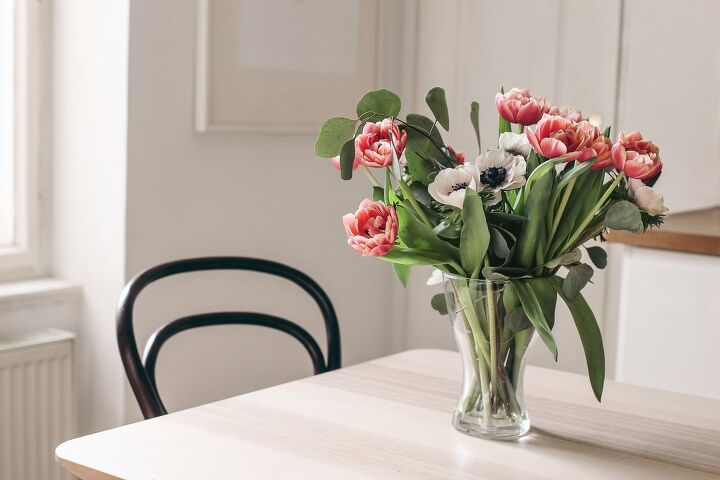10 Ways To Help A Bouquet Of Flowers Last Longer

A bouquet of flowers is the quintessential centerpiece. A flower arrangement breathes life into any room, and there are all sorts of reasons to bring a bouquet into the home. It serves as a classic romantic gesture, provides a lovely accent when you are expecting company, and is a fantastic way to use flowers in your yard. The trick is to do all you can to keep these flowers alive, so you can enjoy your bouquet for as long as possible.
To help make a bouquet of flowers last longer, make sure you cut each stem at a 45-degree angle before placing them in a vase. Use lukewarm water in the vase, and consider adding plant food to the water. Change water frequently and cut the stems each time. Keep your vase in a cool dark place, and remember to trim off any leaves that might touch the water.
Flower arranging is an art form, and keeping your bouquet alive is a combination of art and science. Flowers bring lots of joy, especially when they are a gift or hold sentimental value. Keep reading to learn about how long flowers typically stay alive once cut, and all the tricks you can try to help your flower bouquet live longer.
How Long Should A Bouquet Of Flowers Last In Your Home?
Before you learn how to help keep your flower bouquet alive longer, it’s good to know how long a bouquet lasts on average. Generally, a bouquet of fresh flowers will last five to seven days in any type of vase at home. Hearty tropical flowers tend to last a bit longer, around seven to 10 days.
There are, of course, many variables at play. Where you place the flowers, the temperature of your home, how frequently you care for your flowers, and even the type of flowers all impact how long a bouquet will last. If you want your flowers to last longer than a week, you can usually achieve this goal by following the tips below.
10 Ways To Help Fresh Cuts Flowers Last Longer
1. Change Water Frequently
One of the best ways to extend the life expectancy of your flower bouquet is to change the water in the vase frequently. Water is what keeps your flowers alive. They need to be submerged in fresh water so they can drink and stay resilient.
Over time, water gets murky from plant waste and objects in the air. This can cause bacteria to grow, which can quickly kill the stems. Empty the water in your vase every day or two, and replenish it with fresh water for best results.
2. Cut Stems At A 45-Degree Angle
If you want to make sure your flowers last as long as possible, you need to re-cut the stems before putting them in a vase. You might be apprehensive to do this, especially if they are perfectly arranged, but this is where pruning shears come in handy.
A fresh cut allows each stem to easily absorb and drink the water they need. Remember to cut the stems as close to a 45-degree angle as possible. This type of cut maximizes the surface area of the stem that is exposed to the water and helps make it easier for the flowers to absorb water.
3. Keep Flowers In A Cool Dark Place
You also need to carefully consider where to put your flowers when trying to maximize their lifespan. You might think keeping cut flowers in direct sunlight is the best thing for them. After all, rooted flowers need sunlight. But when it comes to cut flowers in a vase, you want to keep them in a cool dark place.
Warm temperatures and sunny conditions can stress the petals and cause them to wilt and droop. Find a nice cool location that is not near a sunny window to display your flowers. You can even place flowers in the refrigerator at night if you live in a warm climate. Just make sure the fridge is not too close to freezing, as this will kill the flowers.
4. Remove The Lower Leaves On Each Stem
To help make your bouquet last as long as possible, you should remove excess leaves. Most notably, you should get rid of any leaves on the lower portion of the stem that might be in contact with water.
If you allow these leaves to fester in water, they will quickly rot, which causes a rapid buildup of bacteria in the water. As a rule, keep the stems clean and streamlined, especially the portion that is submerged in water.
5. Make Your Own Flower Food
In addition to water, you can feed the flowers some extra nutrients to keep them alive and resilient. Sometimes a bouquet comes with a packet of plant food, which you should use if you have it.
Otherwise, you can make your own solution using a mixture of bleach, vinegar, and sugar. The bleach keeps bacteria at bay, the vinegar balances the pH, and the sugar gives the flowers extra nutrition.
6. Use Lukewarm Water (Not Hot Or Cold)
Remember, when filling your vase with water, the temperature of the water matters. To help your floral bouquet last longer, you should use lukewarm water. When water is at this tepid temperature, it can quickly drink it. If you use hot or cold water, the flowers can go into shock, and in extreme circumstances, they can even die. Instead, use water that is slightly above room temperature, and feels lukewarm to the touch.
7. Keep Flowers Away From Fresh Fruits And Vegetables
If you are someone who likes to display a bowl of fresh fruit, make sure you keep it far away from your flower arrangement. Many fruits and vegetables give off a phytohormone called ethylene. Ethylene is a natural ripening agent, and when it is in the air, it can cause fruit to ripen and flowers to rot. Bananas are particularly high in ethylene, so keep them away from your bouquet.
8. Trim The Stems When You Change The Water
You must trim the stems before placing them in a vase for the first time, but it also helps if you repeat this process each time you change the water. Plants naturally close up, so a fresh cut allows them easier access to water. It is a good habit to trim the stems about one centimeter, keeping them at a 45-degree angle, each time you change the water.
9. Remove Dead Stems And Leaves
As time goes on, you are likely to find that some flowers last longer than others. This is particularly true when you have a mixed bouquet with many flower varieties. As you notice flowers beginning to droop, wilt, and die, remove them promptly. This keeps your bouquet looking stunning and lively. It also helps prevent rot and bacteria from taking over.
10. Choose More Resilient Flowers
Lastly, if you are specifically looking for flower bouquets that will last longer, consider choosing flowers that are known to last for much longer than a week. Choosing more resilient flowers helps ensure your bouquet will last longer. Several flowers are known for their longevity.
Carnations, chrysanthemums, freesias, and sunflowers are all common flowers that are known to last longer than a week. Tropical flowers, including heliconia, birds of paradise, and several orchid species are also known to last much longer than a week if properly cared for.
Summing Up How To Make A Bouquet Of Flowers Last Longer
Having fresh-cut flowers in the home is an excellent way to add bursts of color, life, and elegance to your home. But flowers are not cheap, and they also don’t last forever. The good news is there are several ways you can help your flower arrangement last longer.
Remember to trim them at a 45-degree angle and remove extra leaves from the stem before placing them in water. Add plant food to the water, and make sure the water itself is lukewarm. Keep your flowers in a cool dark place, and far away from fresh fruits and vegetables. Lastly, when buying fresh-cut flowers, consider purchasing varieties that are known to last a long time.
Related Guides:

Tom Gaffey is an expert writer who currently resides in Washington D.C. Tom has a passion for real estate and home improvement writing, as well as travel and lifestyle writing. He lived the last twelve years in Hawaii where he worked closely with luxury resorts and event planners, mastering his knowledge of aesthetics and luxury products. This is where he found his passion for home improvement and a keen interest in DIY projects. Currently, Tom resides in Washington D.C, and also working on his debut fiction novel.
More by Tom Gaffey











![10 Best Electric Lawn Mowers - [2022 Reviews & Top Rated Models]](https://cdn-fastly.upgradedhome.com/media/2023/07/31/9070486/10-best-electric-lawn-mowers-2022-reviews-top-rated-models.jpg?size=350x220)















